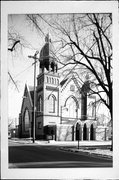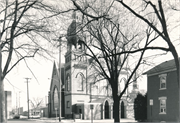Property Record
304 N 6th St (Was 313 N 5TH ST)
Architecture and History Inventory
| Historic Name: | Evangelical Lutheran St. Johann Kirche |
|---|---|
| Other Name: | St. John's Evangelical Lutheran Church |
| Contributing: | |
| Reference Number: | 74901 |
| Location (Address): | 304 N 6th St (Was 313 N 5TH ST) |
|---|---|
| County: | Jefferson |
| City: | Watertown |
| Township/Village: | |
| Unincorporated Community: | |
| Town: | |
| Range: | |
| Direction: | |
| Section: | |
| Quarter Section: | |
| Quarter/Quarter Section: |
| Year Built: | 1907 |
|---|---|
| Additions: | 1950 1967 |
| Survey Date: | 1986 |
| Historic Use: | house of worship |
| Architectural Style: | Early Gothic Revival |
| Structural System: | |
| Wall Material: | Brick |
| Architect: | F.l. Lindsay |
| Other Buildings On Site: | |
| Demolished?: | No |
| Demolished Date: |
| National/State Register Listing Name: | Not listed |
|---|---|
| National Register Listing Date: | |
| State Register Listing Date: |
| Additional Information: | A 'site file' exists for this property. It contains additional information such as correspondence, newspaper clippings, or historical information. It is a public record and may be viewed in person at the Wisconsin Historical Society, State Historic Preservation Office. This building was the third structure built for St. John's Lutheran Church. St. John's began services around 1851 and was formally established in 1852. At first, the group met in a small school building. The congregation was founded by orthodox "Old Lutheran" German immigrants who were disenchanted with the German State Church in their homeland. These "Old Lutherans" affiliated with the Missouri Synod and in 1854, St. John's affiliated with this synod. The congregation completed a church building in 1855 and organized a parochial school in that year. In 1865 a new church was built and a new school built in 1885. In 1908 the congregation built this church on the site of the old church. In 1954 the old St. John's school was replaced with a new building and the church itself underwent an extensive remodeling in 1967-68. In 1972 some of the church's members became disenchanted with the Missouri Synod and a majority of church members voted to leave the Synod. A number of families who did not vote to leave the Synod established a new Missouri Synod Church in that year: Good Shephard Lutheran Church. St. John's joined a small, conservative synod. This building has some significance for local history A because of its association with the development of German ethnic organizations in Watertown. German settlers in Wisconsin came with diverse religious views. One group was the "Old Lutherans" who were conservative Lutherans disenchanted with the German State Church. Eventually the Missouri Synod came to reflect the congregations of these Lutherans. The St. John's Church was a German church that held services in German and established a German Lutheran School. It remained a strongly German church until well into the twentieth century. Unfortunately, the church built in 1908, or the present church, is not the pioneer building of this organization, however, as the only extant building that is related to this particular group of German Lutherans, it is locally significant for ethnic history. Built in the Gothic Revival style in 1907, St. John's Lutheran Church's gabled facade is flanked on the north by a staged square tower with open pointed arched openings directly beneath the domical tile covered tower, which is topped by a turret and a cross. On the south side, the facade is flanked by a shorter tower with domical tile covered roof and topped by a turret similar to that on the north tower. Blind pointed arches, corbelled brick and pointed arched stained glass windows with raised brick molding in recessed panels further characterize the towers. The south tower has bracketed eaves while the north tower has a balustrade on the roof of the second stage. Point arched stained glass windows, stepped buttresses, blind arches and corbelling along the gables further ornament the facade and side elevations. Late pointed arch stained glass windows with raised brick molding along the arch ornament the center of the facade and the north-south transept ends. A one story entrance with three pointed arch portals added to the front of the church in 1967 has significantly altered the integrity of the facade while a large rear brick church office has been added to the rear of the church. St. John's Evangelical Lutheran Church was a significant example of the Gothic Revival style. However, the alteration of the entrance and tower facade as well as the rear addition has compromised the integrity of the Gothic Revival design. However, if the church is restored, St. John's should be reevaluated for architectural significance. Examples of extant early 20th century Gothic Revival church architecture with better integrity in the city of Watertown include the Moravian Church at 510 Cole Street (49-22) and the First Baptist Church at 315 So. 5th (41-8). |
|---|---|
| Bibliographic References: | (A) Building inscription. (B) A Brief History of St. John's Evangelical Lutheran Church, 1952, files, Archives, Octagon House, Watertown Historical Society, Watertown, pp. 8-25.. (C) Watertown Daily Times Feb. 17, 1950; Oct. 3, 1968. (D) St. John's Lutheran Church newspaper subject files, Watertown Public Library. The Improvement Bulletin 1/26/1907. |
| Wisconsin Architecture and History Inventory, State Historic Preservation Office, Wisconsin Historical Society, Madison, Wisconsin |





